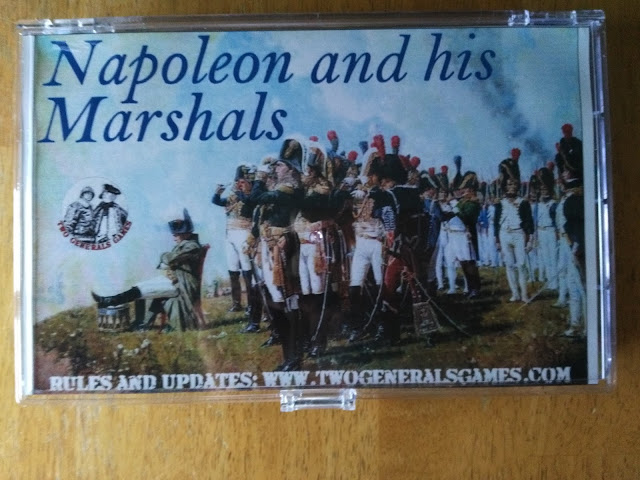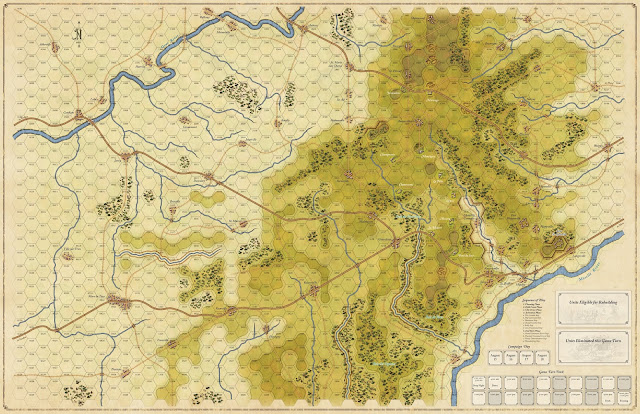The rules are long at seventy-nine pages. This might make some people pause. However I believe most of us have tablets or phones that it can be downloaded to. As mentioned, you do not get the rules or scenario booklet with the game. If this was to save money to make the counters and map better, then it worked.
The unit counter types in the games are as follows:
Infantry
Cavalry
Artillery
Leaders
Supply/Depot
Naval
Forts are also in the game, but they are shown on the map.
 |
| The map |
The games turn mechanics are a bit different from the norm. There are six two month strategic turns (Jan-Feb). Within the six strategic turns are six operational turns for each strategic one. This is not just an operational game, but a strategic one. So in effect you are running your entire country or countries' war and peace efforts (in the campaign game). As a king or emperor you have to decide your country's production, replacements, and policy, and also mobilization and demobilization. Each strategic turn, the phasing player may purchase 'Command Points' which are used to activate leaders, units, or other actions. Movement and combat take place during the operational turns.
 |
| The outside of the counter box/tray |
Supply and lines of communication are important in the game. As a matter of fact, they take up four pages of the rule book. Lack of supply and attrition can kill your armies much quicker than losing battles.
Leaders and their various abilities, and the rules of what they can do is another important part of the game and rule-book. Leaders affect activation, movement, combat, reinforcement, and also have special abilities. Napoleon has the ability to 'split' the coalition armies that he is fighting into their separate national units. Wellington can remove disruption on British units that suffer it during battle.
 |
| The inside of the counter box/tray |
As I mentioned, the rules and scenarios are a download only, but that means anyone interested in looking at them can peruse them at their leisure.The rules for combat are unique and quite involved. There is a CRT, but there are no dice rolls. First the attacker figures out the defender's losses and then the defender checks on the attacker's losses. They both take place at the instance of combat. Meaning that the defender doesn't take casualties, and then checks on the attacker's losses after his losses are deducted. So if both the attackers have a combat number of twenty, twenty would be where on the CRT you would check for casualties to both (terrain etc. are also added in). The leader with a stack can 'protect' or absorb losses. So the higher the number of the leader the easier to absorb losses. In this, the French have an ace up their sleeve until the latter years of the Napoleonic conflict. I am making it seem more involved then it really is. I will include a link to both the scenario rules and the rule-book at the bottom.
So what we are looking at is a game that tries to recreate the Napoleonic years in a game format. The following is a list of the scenarios and the 'game set' you need to play them:
1805 Introductory Scenario - (solo, or two players; requires only basic set) Napoleon attacks Austria in 1805, culminating in the Battle of Austerlitz in which he decisively defeated Austria and Russia.The French can follow the Danube(historical), attack through Bohemia, or come from Italy. Will Austria fall back to join the slow Russians and risk losing
most of its production, or stay forward and risk losing most of its army?
1805 - 1807 Campaign Game - (requires only basic set)
France must be prepared to take on three opponents at once (Russia, Austria and Prussia), plus a fourth one (Britain) that finances the others. Napoleon must nimbly defeat each one at a time, or risk facing them all together.
2-France, All other nations
3-France, Austria/Britain, Russia/Prussia
4-France, Britain/Russia, Austria, Prussia
5-France, Britain, Russia, Austria, Prussia
1809 Scenario - (requires only basic set)
Austria has completed Army Reform and increased the size of its army and is ready to take on Napoleon again, but without Prussia or Russia to help.
2-Franceand Russia, All other nations
3-France, Britain/Austria, Russia(only recommended if the optional rule for full Russian participation is included)
1807-1810 Scenario - (requires basic set plus Peninsular War set
and expansion maps are optional) Napoleon must deal with the "Spanish ulcer" and a resurgent Austria at once.
2-France, All other nations
3-France, Britain/Prussia, Austria/Russia
4-France, Britain/Prussia, Austria, Russia
5-France, Britain, Russia, Austria, Prussia
1811-1814 Scenario - Zenith and Nadir(requires all games in set)
France is victorious everywhere but Spain, and that is encouraging Russia to resist once again. Can Napoleon defeat the Russians once and for all while handcuffed in Spain, or will he try to defeat Spain before Russia can liberate Germany and get Prussia and Austria as allies?
2-France, All other nations
3-France, Austria/Britain, Russia/Prussia
4-France, Britain/Russia, Austria, Prussia
5-France, Britain, Russia, Austria, Prussia
1812 Scenario -The Patriotic War
(requires basic set plus expanded maps)
Napoleon puts together his largest army ever to defeat his biggest continental rival. But can LaGrande Armee repeat its successes in such a large nation against a foe that is prepared to fight it?
1813-1814 Scenario - German and French Campaigns (requires basic set or add on Peninsular War)
Following the loss of most of his army, Napoleon must scramble to retain his client states, and rebuild his army. Can he hold the now united Coalition off long enough to achieve the impossible yet again?
1815 Scenario (requires basic set and Peninsular War set)
Can Napoleon retake France and return it to glory? Or will he face another Waterloo?
2-France, All other nations
1807/1809-1814 Peninsular War Scenarios (requires basic set plus Peninsular War set) A long scenario, starting in either 1807 or 1809, with a small number of units, the players will have to face the limitations of a small war in a poor nation with terrible terrain for campaigning and a long sea coast that favors Britain's best asset-the Royal Navy.
2-France, Britain & allies
1805-1815 Campaign Game (requires basic game and all expansions)
The entire French Napoleonic Wars, from 1805 to 1815. Up to 396 operation turns and 66 Strategic Turns. Expect to play
for 130 hours or so. That's about 32 weeks if you play 4 hours once a week. Play tests averaged about 4 months.
2-France, All other nations (the Coalition)
3- France, Russia, Britain/Prussia/Austria.
Alternatively, Russia with either Prussia or Austria, Britain with either Prussia or Austria
4-France, Britain, Russia, Austria/Prussia
 |
| The counter setup for the 1805 scenario |
As you can tell, I am very impressed by the game's components. As far as the game play I am somewhat impressed. This might be because as a person who has rolled a die for most of the last fifty years on a CRT, new things are hard to learn. I have played other games that do not use die rolls for the CRT, but those have made the function of combat in these games relatively easy. Combat in this game was a bit hard to get a grasp on until I worked through a few examples for myself. The rule-book does have examples and I probably just needed hands on to get the gist of it. As I mentioned at the beginning, I was looking for a replacement for a tried and true friend. I am not sure I have met the replacement as added another good friend to my table. The game has so much more to offer (marching to the guns etc.), than I can mention in this small space. Please take a look at the link below.
http
://www.twogeneralsgames.com/index.php/news/109-update-napoleon-rules-and-scenarios
Robert




















Follow Us